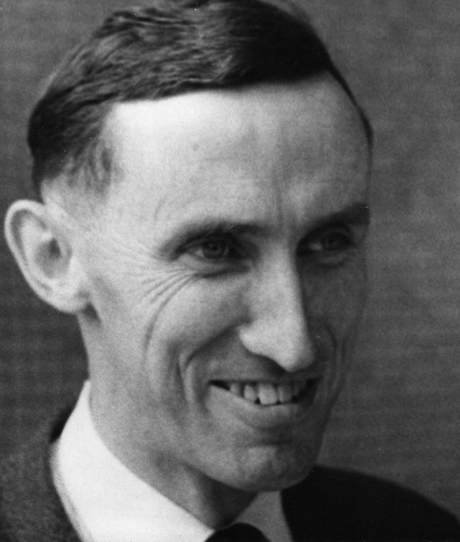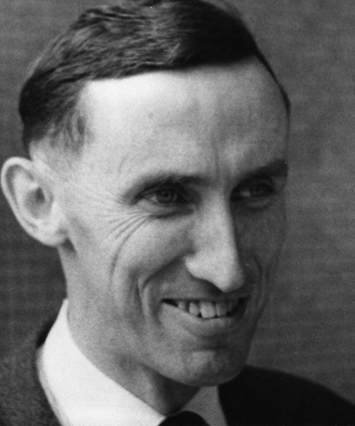William Cameron-Johnson was resident designer at MRA's Westminster Theatre in London, an able graphic designer and a prolific book illustrator. From his early twenties, Bill Cameron-Johnson ("W. Cameron Johnson") devoted his talents to Moral Rearmament, the world-wide spiritual and ethical movement founded by Frank Buchman in 1938. He was resident designer at the MRA's Westminster Theatre in London for 15 years and art director of its American film studio for eight years.
He was also an able graphic designer and a prolific book illustrator. His cartoon handbook Where Do We Go From Here? (co-authored with Hannen Foss, 1952), the first of many books he illustrated, was printed in 25 languages and sold hundreds of thousands of copies all over the world.
Cameron-Johnson delighted in poetry and history - having a particular fascination for heraldic design - and was possessed of an engaging sense of humour. Yet his talents were matched by an unassuming modesty and lack of self-promotion. He was a humble man and this reflected his Christian faith. He was a great encourager of others' projects and had a particular rapport with young people.
Bill Cameron-Johnson grew up in Gloucestershire and, although as an adult he lived mainly in London and the United States, he retained a West Country "burr" to the end of his life. After serving with the Coldstream Guards from 1944 to 1947, he trained as an illustrator at the Borough Polytechnic in south London.
On leaving art school he decided to put himself at the service of MRA. Under the working name W. Cameron Johnson, he was in demand as a cartoonist and illustrator for MRA's publications, as a set designer for plays at MRA's international centre in Caux, Switzerland, and for movies at the MRA film studio on Mackmac Island, Michigan. He designed the sets for MRA's first professional production at the Westminster Theatre, The Hurricane (1961), and returned to America to design the film Voice of the Hurricane (1964), based on the play and starring the African-American mezzo-soprano Muriel Smith. Work on the film design took him to Kenya, where he sketched ‘colonial'-style residences for his film sets.
In 1965 Cameron-Johnson, with his American wife Phyllis, returned to London to design sets, in bright Van Gogh colours, for the family show Give a Dog a Bone, which was to run for 11 Christmas seasons at the Westminster Theatre. He also designed the publicity for the show and the sets for the 1965 film version. There followed a stream of stage designs at the Westminster, among them Happy Deathday, for which Cameron-Johnson also designed film sets, Mr Wilberforce MP, Hideout, Ride! Ride!, Fire and Gavin and the Monster.
He was visual director of the multimedia production Cross Road (1972), which involved creating new techniques for designing and drawing for large-screen projection and which was also made into a film the following year. This led him to devise a number of other multimedia productions, including his History of Theatre, which delighted the thousands of schoolchildren who attended the Westminster's educational programme, A Day of London Theatre, and which was later made into a film-strip and video. He produced similar productions on the Labour pioneer Keir Hardie and, most recently, William Wilberforce and the Anti-Slavery Campaigners, also now on video.
At the same time Cameron-Johnson was in demand as a graphic designer for theatre and film publicity material and as an illustrator for books. He produced book jackets for more than 20 titles. But perhaps dearest to his heart were the illustrated children's books he worked on with his wife Phyllis as editor, Engine People (by Marianne Lindroos, 1980), Return of the Indian Spirit (by Vinson Brown, 1981), Chico the Street Boy (by Evelyn Puig, 1984) and particularly Boy on a Bus (1990), which he both devised and illustrated.
Two and a half weeks into the crippling effects of a brain tumour, he managed to complete the designs for a photographic exhibition commissioned by the current owners of the Mackinac Island studio, now encompassed within a large hotel and conference centre. He had also begun producing exquisite colour drawings for a one-man stage version of The Legend of the Fourth King to be performed by his friend the Parisian actor Michel Orphelin, but the rapid spread of the cancer meant that his part in the project had to be abandoned.
by Hugh Steadman Williams
William George Cameron-Johnson, theatre and film designer, graphic artist, illustrator and cartoonist: born Gloucester 9 March 1926: married 1958 Phyllis Kaempfer; died London 11 July 2000.
This article first appeared in the Independent on 28 July 2000
English


